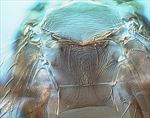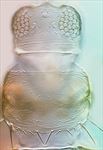
achaetus head & pronotum

achaetus antenna

achaetus meso & metanota

frankstoni head & pronotum

frankstoni tergites VII-IX
Generic diagnosis
Female macropterous. Head wider than long; maxillary palps 3-segmented; eyes without pigmented facets; ocellar setae I present, pair III small, arising between hind ocelli; 5 pairs of small postocular setae. Antennae 8-segmented, III–IV with small, forked sense cone; III–VI with rows of microtrichia on both surfaces. Pronotum either with two pairs of prominent posteroangular setae, or with no long setae. Mesonotum trasversely reticulate/striate, median setae close to posterior margin; anterior campaniform sensilla present. Metanotum with sculpture lines mainly longitudinal, median setae at anterior margin; campaniform sensilla present or absent. Fore wing first and second veins with complete row of setae; clavus with 6 veinal and one discal setae. Prosternal ferna continuous; basantra membranous, without setae; prospinasternum broad and transverse. Mesosternum with sternopleural sutures complete; endofurca with spinula. Metasternal endofurca without spinula. Tarsi 2-segmented. Tergites without craspeda; ctenidia usually absent on V–VII; VIII with pair of weak ctenidia anterolateral to spiracle, posteromarginal comb with median microtrichia sometimes longer than those laterally. Sternites without discal setae; VII with setae S1 arising at margin.
Male similar to female; sternites III–VII each with transverse pore plate; sternite margins sometimes with microtrichia.
Biological data
The members of this genus are all known to breed in flowers, particularly but not exclusively in Asteraceae flowers.
Distribution data
Eight of the nine species in this genus are from Australia, with querci based on a single female recorded in 1920 from Taiwan. Extensive collecting of thrips in Taiwan in recent years has not re-discovered this species (Wang, 2002). However, Bhatti (1978) has recorded 11 females of querci collected at various sites in Java between 1912 and 1923. The type species of the genus, achaetus, although originally from Australia, has been introduced both to Hawaii and California (Mound et al., 2017).
Nomenclatural data
Pseudanaphothrips Karny, 1921: 242. Type species Pseudothrips achaetus Bagnall, by subsequent designation.
Nine species are recognised in this genus, all from Australia except querci, but with the type species widespread to various countries.
querci (Moulton, 1928: 306) (Isochaetothrips)
Relationship data
Thripidae sub-family Thripinae: this is a diverse group involving more than 230 genera. Members of this Australian genus share several character states with species of Frankliniella, although the tergal ctenidia are less well developed (Mound, 2002; Wang et al., 2019).
References
Bhatti JS (1978) Preliminary revision of Taeniothrips. Oriental Insects 12: 157–199.
Mound LA (2002) The Thrips and Frankliniella genus groups: the phylogenetic significance of ctenidia. Pp. 379-386 in Marullo R & Mound LA [eds] Thrips and Tospoviruses: Proceedings of the 7th International Symposium on Thysanoptera. Australian National Insect Collection, Canberra. http://www.ento.csiro.au/thysanoptera/symposium.php
Mound LA, Matsunaga J, Bushe B, Hoddle MS & Wells A (2017) Adventive Thysanoptera Species on the Hawaiian Islands: New Records and Putative Host Associations. Proceedings of the Hawaiian Entomological Society 49: 17–28.
Wang CL (2002) Thrips of Taiwan: Biology and Taxonomy. Special Publication No. 99. Taiwan Agricultural Research Insititute, Taichung. 328pp.
Wang ZH, Mound LA & Tong XL (2019) Phylogenetic relationships within the Frankliniella genus-group based on morphology, with a revision of Iridothrips (Thysanoptera, Thripidae). Zootaxa 4651 (1): 141–154.